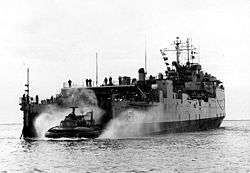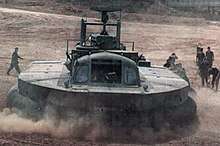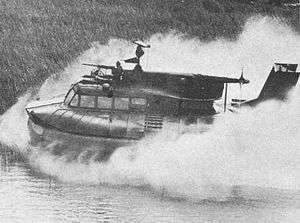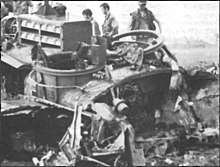Patrol Air Cushion Vehicle
 Task Force 116 "Game Warden" PACV in Vietnam | |
| Class overview | |
|---|---|
| Name: | PACV |
| Builders: | British Hovercraft Corporation, Bell Aerosystems |
| Operators: | |
| Built: | 1965 |
| In commission: | 1966–1970[1] |
| Completed: | 6 |
| Lost: | 2[1] |
| General characteristics | |
| Type: | Hovercraft |
| Tonnage: | 15,660 pounds (7.10 tonnes)[2] |
| Length: | 38 ft 10 in (11.83 m)[2] |
| Beam: | 23 ft 9 in (7.24 m)[2] |
| Installed power: | 1014 hp |
| Propulsion: | GE 7LM100-PJ102 gas turbine[1] |
| Speed: | 60 kn (110 km/h; 69 mph) maximum[2][3] |
| Range: | 165 nmi (306 km)[2] |
| Troops: | 12[4] |
| Crew: | 4[2] |
| Sensors and processing systems: |
|
| Armament: | .50 cal M2 machine gun, 2x M60 machine guns[2] |
| Armor: |
|

The Patrol Air Cushion Vehicle (PACV), also known as the Air Cushion Vehicle (ACV) in Army service, was a United States Navy and Army hovercraft used as a riverine patrol boat during the Vietnam War. Six hovercraft were built, three for the Army and three for the Navy. Two of the Army hovercraft were destroyed by the Viet Cong.
Development
The PACV was based on the Bell Aerosystems Bell SK-5 hovercraft; a licensed version of the British Saunders-Roe (later, British Hovercraft Corporation) SR.N5 hovercraft. The SK-5 was adapted for American military use in 1965. Three were purchased by the US Navy for operations in the emerging Vietnam War. Training of PACV crews was performed in the waters off Coronado, California near San Diego.
Design
Two different designs were made: one for the Navy and one for the Army. The Navy's hovercraft, called Patrol Air Cushion Vehicles, more closely resembled the civilian SK-5s that they were based off.

Both designs were powered by the same GE 7LM100-PJ102 engine. The engine, its 304 gallon (1,150 litre) fuel tank, an auxiliary power unit, and the Westland transmission were located amidships. The transmission served to link the engine and lift fan so that the fan could provide lift and thrust. Twin rudders and elevators sat behind the fans.[1]
The Army hovercraft, called Air Cushion Vehicles, had more extensive modifications. They had heavier armor and reinforced, load-bearing decks. Army ACVs carried 1,000 pounds (450 kg) of armor—roughly equal to that of an M113 armored personnel carrier. The armor was thickest around the engine, transmission, and fuel tanks, providing protection from .50 caliber rounds fired at 200 yards (180 m), while the armor around the crew compartment could only block .30 caliber rounds fired at 100 yards (91 m).[1]:14 To save weight, many ACV and PACV crews removed the armor around the crew compartment, and an Army evaluation recommended that it be removed altogether.[1]:14, 18
The communications package consisted of a six-station intercom system, UHF radios, and a radio security set. The boats were shipped with AN/ARC-54 FM radios. However, these proved unreliable, with an operational ready rate of only 35 percent. Army units sought to replace them with VRC-125s. While it is not known if this replacement occurred, one ACV did receive a VRC-46 radio.[1] The hovercraft carried a Decca 202 radar dish, which could detect targets within 24 miles (39 km). Some Army ACVs were also fitted with XM34APD Personnel Detectors (better known as "people sniffers"), which could detect carbon, ammonia, and sigma emissions, the latter discharge being distinctive to humans. This equipment was used to find hidden enemies. Dog teams were also sometimes carried to help detect enemies.[1]
The PACV were armed with a .50 caliber M2 Browning machine gun in a roof-mounted turret in the front and two 7.62mm M60 machine guns, one port and one starboard. The Army initially planned to outfit their hovercraft with a minigun and Mk 19 automatic grenade launchers.[5] Only one ACV was outfitted with a grenade launcher, however, and the miniguns were removed to make space for more troops and cargo.[6]
The Army ACVs had other improvements over the Navy PACVs beyond their additional armor, namely a wider cockpit, two gun positions instead of one, and a flat deck on top of the skirt for troops to ride on.[7]

Operational history
PACVs were first deployed to Vietnam in May 1966 as PACV Division 107, Task Force 116, where they were used for riverine patrol missions in the Mekong Delta and on the Mekong River.[7] Often called "Pac Vees", they were armed with a .50 caliber machine gun mounted on a rotational platform in the front and two side mounted M60 machine guns. In addition, the crew, and often US Army Green Berets and ARVN Rangers, riding on the side panels, employed assorted small arms such as M16 rifles and M79 grenade launchers as well as various other rifles, .45 pistols, light and medium machine guns, and grenades,[7] although using small arms was dangerous because spent casings could fall into the propeller.[4] The PACV was used to prevent Viet Cong infiltration from the sea and tidal areas along river mouths and deltas.[8] It was especially useful in shallow marshy areas, especially the Mekong Delta, where other patrol boats such as the Patrol Boat River could not go.[8][9]
The PACV's relatively light weight of only seven tonnes meant that it could be easily carried by a CH-53 helicopter. This allowed it to be airlifted between forward operating bases or transported back to base when it suffered damaged. The PACV could also be split into sections and then transported in Air Force transport planes, which was how they were brought to Vietnam.[1]
In November 1966, the Navy PACVs were used to great effect in Operation Quai Vat (Vietnamese for "Monster", which was what the Viet Cong called the PACVs). In the operation, conducted jointly with Vietnamese Civilian Irregular Defense Group troops and US Army helicopters and special forces, the PACV force brought its speed and firepower to bear on the Viet Cong, taking many enemy prisoners, capturing their supplies, and destroying or damaging over 32 of their sampans.[3] This demonstration of combat prowess and capability in the marshy terrains and on the slick grounds found in southwestern Vietnam formed the basis for stationing the Army's ACVs in the Plain of Reeds along the south Vietnamese/Cambodian border. Though the loud noise of the PACVs was still an issue, their speed made up for it in this otherwise difficult terrain, especially during the monsoon season. The PACV could clear rice paddy dikes and other solid obstacles up to 3 feet (0.91 m) high and negotiate slopes of up to 6 feet (1.8 m).[7]
The Navy withdrew the PACVs for overhaul in January 1967 and redeployed them to Vietnam in early 1968.[7] Also in 1967, the Army began to deploy its version of the PACV, the ACV, to Vietnam. There were only three Navy PACVs, and three Army ACVs during the whole Vietnam War. Two of the three ACVs were Assault Air Cushion Vehicles (AACV), weapons-heavy vessels configured for attack missions, while the other was a Transport Air Cushion Vehicle (TACV) configured for logistics missions.[1]:12-13 Both AACVs were lost to Viet Cong attacks.[5] The three Army ACVs were operated by the 39th Cavalry Platoon and were based out of Ben Luc, although they often deployed from fire support bases.[1]

The Green Berets stationed in Moc Hoa became proponents of the PACVs, using them in many of their early operations. Search and destroy raids conducted out of Moc Hoa in November 1966 caught the Viet Cong by surprise and resulted in many Viet Cong deaths.[1]
PACVs conducted many successful missions on the Mekong Delta, Cat Lo, Plain of Reeds out of Moc Hoa in their initial tour. The most successful operation was a wrongful incursion into Cambodia on November 20, 1966 that also involved insertion of South Vietnamese troops by helicopters and MIKE Force Special Forces airboats manned by Chinese Nungs. 56 Vietnamese communist soldiers were killed to one Mike Force WIA. When it was discovered they were in Cambodia, not Vietnam, all units were withdrawn. The communist unit engaged had previously successfully engaged the Hurricane Aircat airboats and Special Forces CIDG forces in South Vietnam on November 14, killing two Americans and wounding one.
The PACV's speed, maneuverability, and firepower lent themselves to many types of missions, including patrolling, search and destroy, escorting other ships, raiding, reconnaissance, and providing fire support to infantry.[1][9] They were best suited for ambushes and raids, especially at night, when they could be easily concealed behind reeds and swamp grass.[1] The PACV was found to be most effective when employed in combined arms operations alongside helicopters, artillery, and other watercraft; patrol missions conducted in concert with Hurricane Aircat airboats were found to be especially effective.[4] The PACV's low profile and radar also meant that it was used as a stealthy stationary radar station when its engines were off.[4] However, Army evaluations found that the ACV had insufficient firepower, being unable to damage armored or fortified targets, and recommended that it be outfitted with heavier weapons such as TOW missiles, 20mm autocannons (such as M139 or M61 Vulcan), or 106mm M40 recoilless rifle.[4] It also found that it could be too loud to be used effectively for patrol and interdiction missions.[4]
Operating these highly specialized vehicles required pilots and maintenance personnel undergo considerable training.[6] Troops riding in and on the PACVs also needed training to use them safely: during evaluation, one soldier died when he fell into the hovercraft's intake,[6] and another lost his hand to the propeller.[1]:13–14
One downside of the PACV was the degree of maintenance it required: each hour of operation required 20 hours of maintenance,[10] a ratio comparable to that of the C-17 Globemaster III airplane[11] and double the 10 hour average for military helicopters.[12] This maintenance requirement, which was made even worse when the vehicles suffered damage, combined with the insufficient firepower to lead an Army evaluation to conclude that "there is no hope of the [PACV/ACV] unit fighting to a satisfactory conclusion in any large engagement."[4]

Because of their high profile and degree of threat, the PACVs and ACVs in Vietnam became major targets. The Viet Cong used ambushes and naval mines against the PACVs. Mines proved especially effective: Army ACV 902 was destroyed by a tripwire-triggered mine on January 9, 1970.[1] Though no one onboard was killed, this attack slowed the pace of ACV operations because of Army regulations stipulating that the hovercraft work in pairs to protect each other. When ACV 901 was destroyed by a command-detonated mine on August 3, 1970, killing three, the ACVs were deactivated.[6] The 39th ACV platoon ceased operations on August 31, 1970, transferring their sole surviving ACV to the Army Transportation Museum in Virginia, and officially left Vietnam in September.[1]
Survivors
The only surviving British Hovercraft Corporation-built US Navy PACV (No. 004) is preserved at the Yanks Air Museum in Chino, California.[13] The last surviving Army ACV (No. 903) is on display at the U.S. Army Transportation Museum in Ft. Eustis, Virginia.[10]
See also
References
- 1 2 3 4 5 6 7 8 9 10 11 12 13 14 15 16 17 18 19 Keaveney, Kevin (July–August 1993). "Cavalry Afloat: The 39th Cavalry Platoon in the Mekong Delta". Armor. Fort Knox: US Army Armor Center. ISSN 0004-2420. Retrieved 6 August 2018.
- 1 2 3 4 5 6 7 "PACV-4". Historic Naval Ships Association. Bellingham International Maritime Museum. Retrieved 6 August 2018.
- 1 2 Martin, Bob (March 1967). "Battle on the Plain of Reeds" (PDF). All Hands. No. 602. Navy Annex, Arlington, Virginia: US Navy Bureau of Naval Personnel. ISSN 0002-5577. Retrieved August 6, 2018.
- 1 2 3 4 5 6 7 8 Moore, David G. (15 August 1968). Trip Report - SK-5 Air Cushion Vehicle (PDF) (Technical report). US Army Combat Development Command. AD849055.
- 1 2 Hutchinson, Harold (May 15, 2018). "The United States used combat hovercraft to kick butt in Vietnam". We are the Mighty. Retrieved September 13, 2018.
- 1 2 3 4 Trevithick, Joe (2014-06-11). "U.S. Army Hovercraft Chased Guerrillas Around the Mekong Delta". War is Boring. Retrieved 2018-08-07.
- 1 2 3 4 5 Stoner, Robert (Spring 2018). "The Brown Water Navy in Vietnam" (PDF). USS Bristol DD 857 Veterans Association Newsletter. Retrieved 13 September 2018.
- 1 2 Neil, Bob (November 1966). "Sailing in the Midget Fleet" (PDF). All Hands. No. 598. Navy Annex, Arlington, Virginia: US Navy Bureau of Naval Personnel. ISSN 0002-5577. Retrieved 6 August 2018.
- 1 2 Eichel, Harry (16 October 1968). "PACVs Patrol Perilous Waters for VC Prey". Navy Times. Retrieved 16 September 2018.
- 1 2 "Rail Pavilion". U.S. Army Transportation Corps Museum. Joint Base Langley-Eustis. January 29, 2018. Retrieved August 20, 2018.
- ↑ "C-17 Globemaster III". Joint Base McGuire-Dix-Lakehurst. June 11, 2007. Retrieved August 20, 2018.
- ↑ Bland, William; Washabaugh Jr., Donald L.; Adams, Mel (April 2017). "Army Aviation: Quantifying the Peacetime and Wartime Maintenance Man-Hour Gaps". Defense Acquisition Research Journal. Defense Acquisition University. 24 (2): 249. doi:10.22594/dau.16-751.24.02.
- ↑ https://yanksair.com
External links
| Wikimedia Commons has media related to Patrol Air Cushion Vehicle. |
Video
- Patrol Air Cushion Vehicles (PACV) used in Vietnam in conjunction with Bell UH-1 Iroquois Huey helicopters Narrated by Hollywood actor Dana Andrews.
_glides_over_the_waters_of_Cau_Hai_Bay_near_Hue._-_NARA_-_558515.tif.jpg)